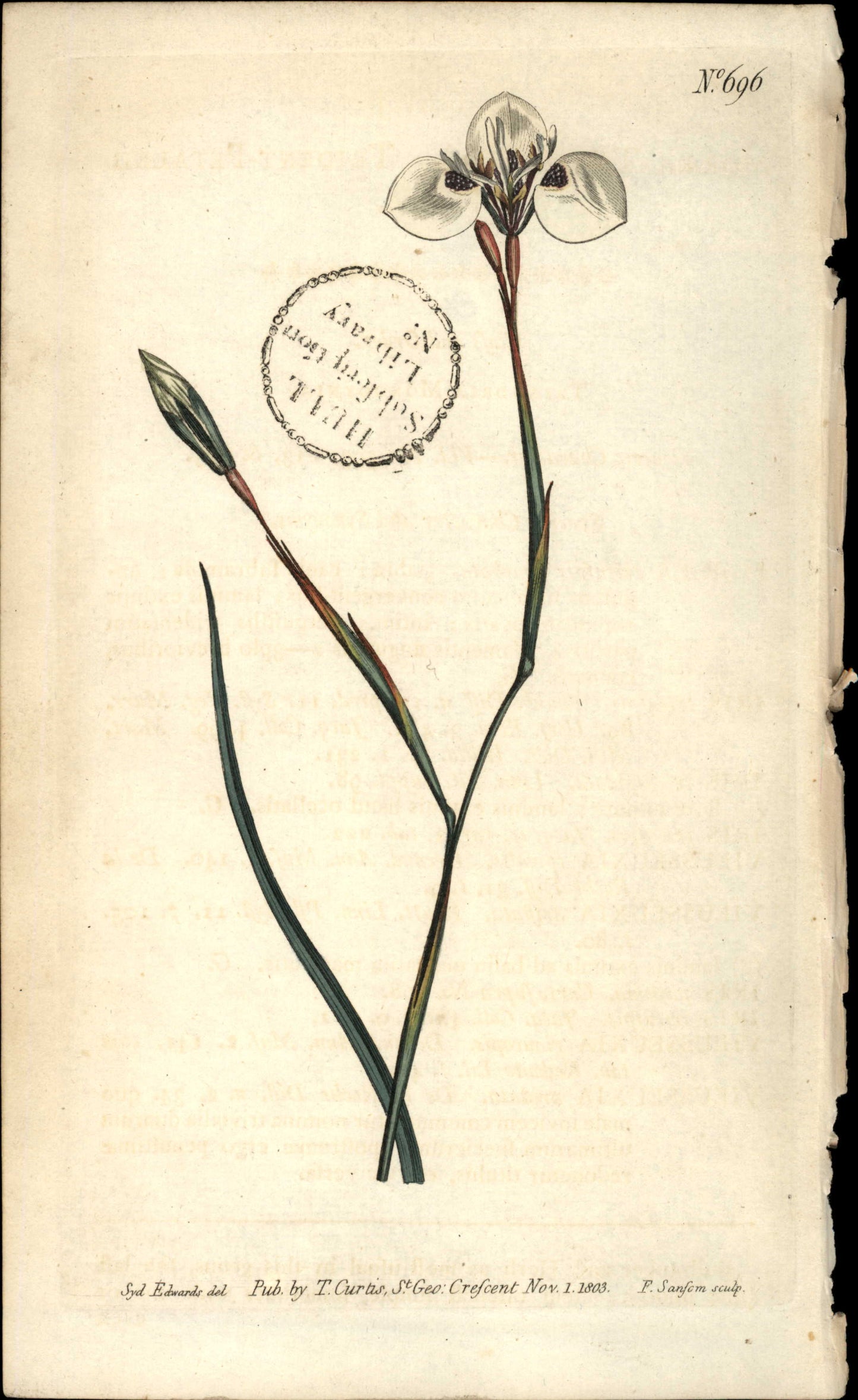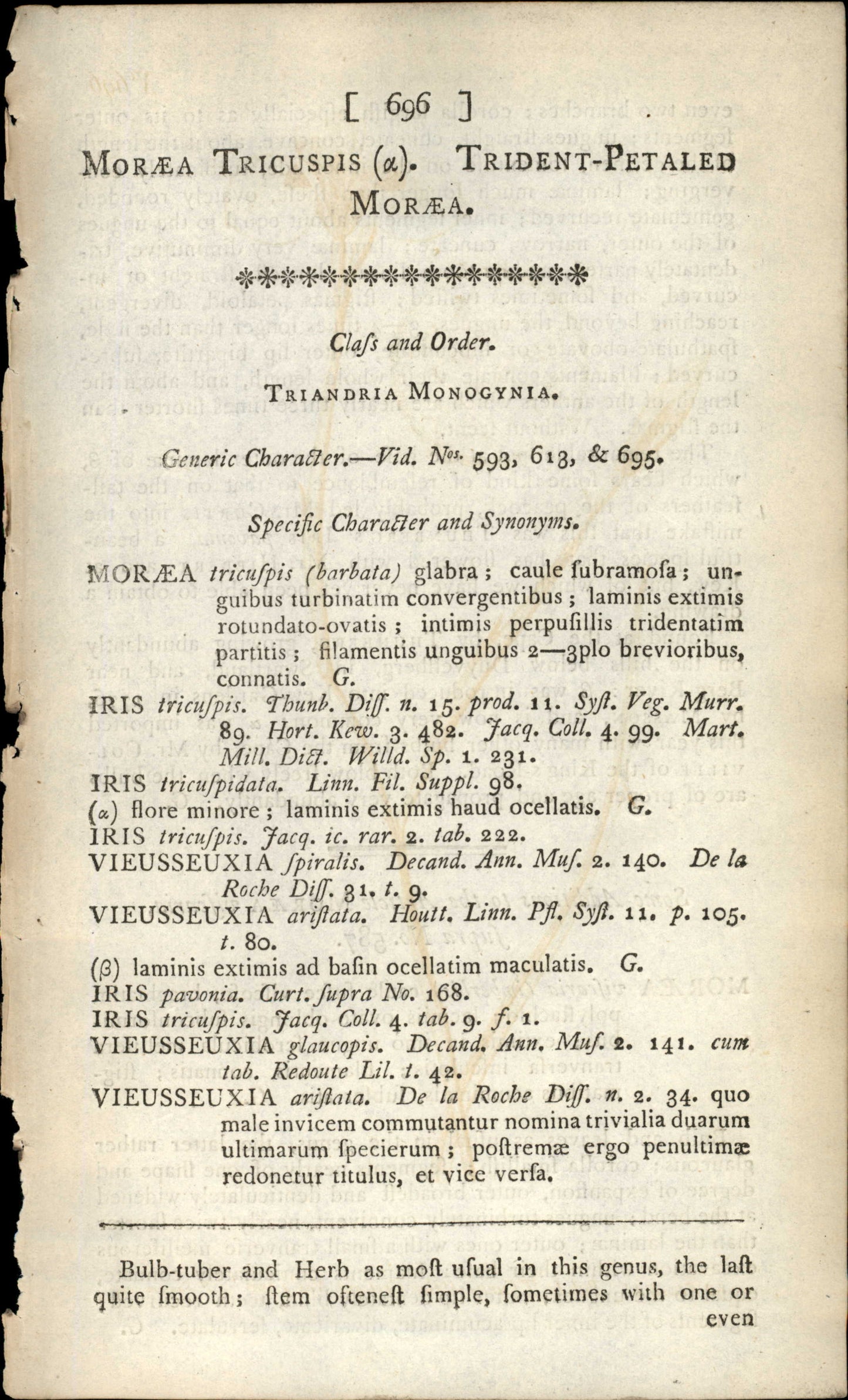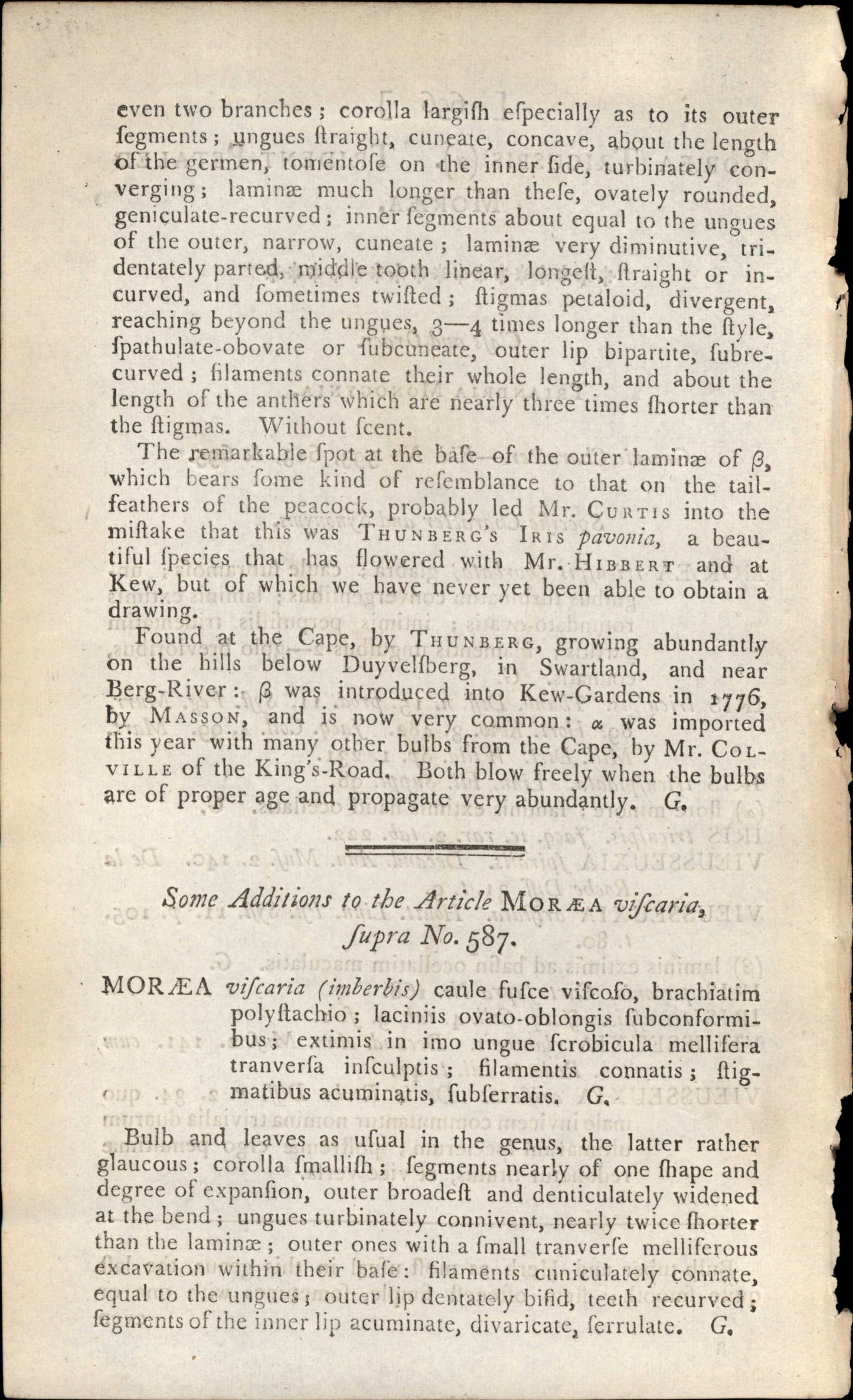Curtis Botanical Magazine
Plate 696 - Triandria Monogynia
Plate 696 - Triandria Monogynia
Couldn't load pickup availability
Plate 696
Classification: TRIANDRIA MONOGYNIA
Publication Date: Nov 1, 1803
Description:
Complete Botanical Text (Cleaned)
N°696 syd Edwards del Pub. by T. Curtis, st Geo: Crefcent Nov. 1. 1803.
Sanfem sculp linis [696] badd 1, 1975 MOREA TRICUsPIS (a).
TRIDENT-PETALED Topo to ide adi anda sit node bas 1, 9110 MOREA. ***************** Class and Order.
TRIANDRIA MONOGYNIA. 10 Generic Character.-Vid.
Nos. 593, 618, & 695. specific Character and synonyms. baziub MOREA tricuspis (barbata) glabra; caule subramosa; un- gido 0 guibus turbinatim convergentibus; laminis extimis rotundato-ovatis ; intimis perpussilis tridentatim whatbands partitis; filamentis unguibus 2-3plo brevioribus, bus connatis.
IRIS tricuspis.
De la Roche Diff. n. 2. 34. quo male invicem commutantur nomina trivialia duarum od ultimarum specierum; postremae ergo penultima bus sqal stredonetur titulus, et vice versa. pb Bulb-tuber and Herb as most usual in this genus, the last quite smooth; stem oftenest simple, sometimes with one or even even two branches; corolla largifh especially as to its outer segments; ungues straight, cuneate, concave, about the length of the germen, tomentofe on the inner fide, turbinately con- verging; laminæ much longer than these, ovately rounded, geniculate-recurved; inner segments about equal to the ungues of the outer, narrow, cuneate; laminæ very diminutive, tri- dentately parted, middle tooth linear, longest, straight or in- curved, and sometimes twifted; stigmas petaloid, divergent, reaching beyond the ungues, 3-4 times longer than the ftyle, fpathulate-obovate or fubcuneate, outer lip bipartite, fubre- curved; filaments connate their whole length, and about the length of the anthers which are nearly three times shorter than the stigmas.
Without fcent.
The remarkable spot at the base of the outer laminæ of ẞ, which bears some kind of refemblance to that on the tail- feathers of the peacock, probably led Mr.
CURTIS into the miftake that this was THUNBERG'S IRIS pavonia, was IRIS pavonia, a beau- tiful species that has flowered with Mr.
HIBBERT and at Kew, but of which we have never yet been able to obtain a drawing. 06 Found at the Cape, by THUNBERG, growing abundantly on the hills below Duyvelfberg, in swartland, and near Berg-River was introduced into Kew-Gardens in 1776, by MAsSON, and is now very common: & was imported this year with many other bulbs from the Cape, by Mr.
COL- VILLE of the King's-Road.
Both blow freely when the bulbs are of proper age and propagate very abundantly.
G.) pot zigmin 2011 al sa opt.
JuM 201 T Some Additions to the Article MOREA vifcaria, Jupra No. 587. .08 Disclosam mislioso naled be aimiko zinims! (8) MOREA vifcaria (imberbis) caule fufce vifcoso, bracthiatim polyftachio; laciniis ovato-oblongis fubconformi- A bus; extimis in imo ungue fcrobicula mellifera tranversa infculptis; filamentis connatis ; ftig- oup gmatibus acuminatis, fubferratis, G. mutsub silsi silsivin Bulb and leaves as usual in the genus, the latter rather glaucous; corolla fmallifh; segments nearly of one shape and degree of expanfion, outer broadeft and denticulately widened at the bend; ungues turbinately connivent, nearly twice shorter than the lamina; outer ones with a fmall tranverfe melliferous excavation within their base: filaments cuniculately connate, equal to the ungues; outer lip dentately bifid, teeth recurved; segments of the inner lip acuminate, divaricate, ferrulate.
G
Raw OCR Text (Original)
¡N Aavaq!'T TH N°696 syd Edwards del Pub. by T. Curtis, st Geo: Crefcent Nov. 1. 1803. F. Sanfem sculp linis [696] badd 1, 1975 MOREA TRICUsPIS (a). TRIDENT-PETALED Topo to ide adi anda sit node bas 1, 9110 MOREA. ***************** id gil Class and Order. TRIANDRIA MONOGYNIA. 10 Generic Character.-Vid. Nos. 593, 618, & 695. specific Character and synonyms. baziub MOREA tricuspis (barbata) glabra; caule subramosa; un- gido 0 guibus turbinatim convergentibus; laminis extimis rotundato-ovatis ; intimis perpussilis tridentatim whatbands partitis; filamentis unguibus 2-3plo brevioribus, bus connatis. G. IRIS tricuspis. Thunb. Diff. n. 15. prod. 11. syst. Veg. Murr. 89. Hort. Kew. 3. 482. Jacq. Coll. 4. 99. Mart. Mill. Dict. Willd. sp. 1. 231. IRIS tricuspidata. Linn. Fil. Suppl. 98. (a) flore minore; laminis extimis haud ocellatis. G. IRIS tricuspis. Jacq. ic. rar. 2. tab. 222. 17 018 VIEUsSEUXIA spiralis. Decand. Ann. Mus. 2. 140. De la Roche Diff. 31. t. 9. VIEUsSEUXIA aristata. Houtt. Linn. Pfl. syst. 11. p. 105. t. 80. (3) laminis extimis ad basin ocellatim maculatis. G. IRIS pavonia. Curt. Jupra No. 168. IRIS tricuspis. Jacq. Coll. 4. tab. 9. f. 1. HOM VIEUsSEUXIA glaucopis. Decand. Ann. Mus. 2. 141. cum -gilenen tab. Redoute Lil. t. 42. VIEUsSEUXIA aristata. De la Roche Diff. n. 2. 34. quo male invicem commutantur nomina trivialia duarum od ultimarum specierum; postremae ergo penultima bus sqal stredonetur titulus, et vice versa. pb Bulb-tuber and Herb as most usual in this genus, the last quite smooth; stem oftenest simple, sometimes with one or even even two branches; corolla largifh especially as to its outer segments; ungues straight, cuneate, concave, about the length of the germen, tomentofe on the inner fide, turbinately con- verging; laminæ much longer than these, ovately rounded, geniculate-recurved; inner segments about equal to the ungues of the outer, narrow, cuneate; laminæ very diminutive, tri- dentately parted, middle tooth linear, longest, straight or in- curved, and sometimes twifted; stigmas petaloid, divergent, reaching beyond the ungues, 3-4 times longer than the ftyle, fpathulate-obovate or fubcuneate, outer lip bipartite, fubre- curved; filaments connate their whole length, and about the length of the anthers which are nearly three times shorter than the stigmas. Without fcent. The remarkable spot at the base of the outer laminæ of ẞ, which bears some kind of refemblance to that on the tail- feathers of the peacock, probably led Mr. CURTIS into the miftake that this was THUNBERG'S IRIS pavonia, was IRIS pavonia, a beau- tiful species that has flowered with Mr. HIBBERT and at Kew, but of which we have never yet been able to obtain a drawing. 06 Found at the Cape, by THUNBERG, growing abundantly on the hills below Duyvelfberg, in swartland, and near Berg-River was introduced into Kew-Gardens in 1776, by MAsSON, and is now very common: & was imported this year with many other bulbs from the Cape, by Mr. COL- VILLE of the King's-Road. Both blow freely when the bulbs are of proper age and propagate very abundantly. G.) pot zigmin 2011 al sa opt. JuM 201 T Some Additions to the Article MOREA vifcaria, Jupra No. 587. .08 Disclosam mislioso naled be aimiko zinims! (8) MOREA vifcaria (imberbis) caule fufce vifcoso, bracthiatim polyftachio; laciniis ovato-oblongis fubconformi- A bus; extimis in imo ungue fcrobicula mellifera tranversa infculptis; filamentis connatis ; ftig- oup gmatibus acuminatis, fubferratis, G. mutsub silsi silsivin Bulb and leaves as usual in the genus, the latter rather glaucous; corolla fmallifh; segments nearly of one shape and degree of expanfion, outer broadeft and denticulately widened at the bend; ungues turbinately connivent, nearly twice shorter than the lamina; outer ones with a fmall tranverfe melliferous excavation within their base: filaments cuniculately connate, equal to the ungues; outer lip dentately bifid, teeth recurved; segments of the inner lip acuminate, divaricate, ferrulate. G.
Original botanical print from Curtis's Botanical Magazine
Share







